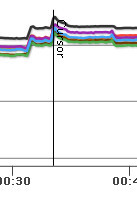boscomantico wrote:
Magneto timing is normally very strictly defined in the TCDS. I would expect that very few IAs would sign off a plane that is more than a degree or so off the value or values in the TCDS…
I don’t even know one who would sign-off with one degree more advanced!
And it’s a real Sophie’s choice, isn’t it, if you were to do the timing (rather illegally) yourself? LOP will be so much easier with that low EGT/TIT… and CHT still acceptable if the baffles are properly sealed. But how much do you eat into the detonation margin by doing that? I understand that early P210s were prone to detonation, until some modifications were done to the fuel and induction systems. Now, how close does one get to detonation with half, one… two or three degrees advanced beyond the TCDS limits??
Centurion_Flyer wrote:
I don’t even know one who would sign-off with one degree more advanced!
Probably no one.
The again, the flower pot system is so hard to use, that I guess you could come out of any annual with +/-1 degree easily.
So one year you would have less problem flying LOP than the previous.
I dont think the P210 is any more prone to detonation than any other 310bhp TSIO-520. Thats just looking at it the wrong way. The engine doesnt know if it sits in a T210 or P210. The venturi on the induction that gives air to the cabin makes no difference if left open.
I have an intercooler, and this probably gives more margin to any detonation event. Then again, you very seldom hear about detonation issues unless there is some sort of fuel issue.
There are several great posts and articles on detonation on BeechTalk.
We can discuss to death on this Forum because few of us have any deeper insight into how the piston engines really operate. Me included.
Ask the question on BeechTalk, and the Gurus give you a clear answers within a short time. And they have the test results to verify what they are saying.
If you want to learn more on how to operate the big bore engines, BeechTalk is a great place to learn. The APS course is an even better way. If you have the possibility. There is an online course available too.
Centurion_Flyer wrote:
Who would you recommend in Europe for that job?
Right now we are trying several options out.
There is some possible good options in Europe too.
However, only longevity will show if it was good enough. I guess anything is better than the crap TCM sends out.
If you have first run cylinders, I would OH those than buy new. Superior is probably a better option, but when does the next AD come along???
I have Superior cylinders on my 1999 custom blueprinted overhaul done in Mena AR, USA; they managed to last the entire 17 year (AD limited) and over 1100 hours of faultless operation. Upon inspection after removal, they looked 100% fit for another 1000 hours. First engine (IO520BA) ran the full TBO run with no cylinder problems (due to old style manual fitting of exhaust valve guides and valves). The second engine (IO520BB) did a full TBO run (2000+ hours) with only one burned exhaust valve detected at annual inspection.
When we did the APS course in Europe last June, there were extensive demos of engines running in light, moderate, heavy detonation (on an engine test stand, not in the air). This is covered in the APS online course as well. A new APS course in Europe may be possible if more than 30 participants can be found.
At over 1000 pilots reading EuroGA daily, that probably vastly exceeds Beechtalk European readership. So it will do more good to post good information here 
Americans have much more choice when it comes to getting work done, too.
Also we don’t have adverts.
A non turbo engine should do 2000hrs unless operated badly, or corroded.
Just downloaded the data from the EDM930 and found a GAMI test.
It seems that I have one cylinder still not playing in tune (number 5).
Unable to upload the file though. Peter can you help? I get the “upload failed error” message.
You can upload images only. See posting tips
If you email it to me i will upload and link it.
Upload to Savvy and post the link.
It is on Savvy. GAMI test at 35 minutes
does this link work?
https://www.savvyanalysis.com/flight/2230032/b128ebbf-5f40-40e0-9eb6-6ff8acb87eeb
Another one with aGAMI test at 54 minuntes
https://www.savvyanalysis.com/flight/2230053/87659df0-f5b0-4fea-9c3a-aa37c32c457a
This is my recent flight with the power-climb to FL200 (one EGT probe broken).
https://www.savvyanalysis.com/flight/2230068/48f801e4-8dfb-4939-903f-928c81fddb65
Can the x scale around the GAMI test be magnified?

Ideally, you need to do the test quite slowly e.g. 0.2USG/hr steps every 30 seconds.